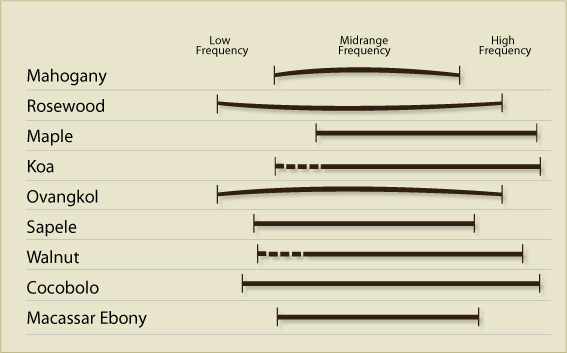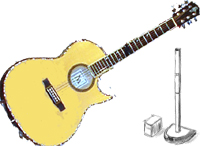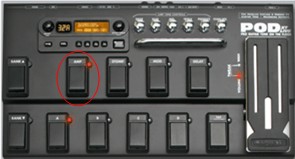Difference between pages "Stereo / Mono / Distributed Systems" and "Acoustic Guitar"
(first ed) |
m (→Tone: http://www.pantheonguitars.com/tonewoods.htm) |
||
| Line 1: | Line 1: | ||
| − | === | + | [[Image:AcousticGuitarL1.jpg|ST's Morgan with L1|right]] |
| − | + | == Pickups and Systems == | |
| + | === Fishman Aura === | ||
| − | + | "If you want high gain, you would use all pickup and no mic on the blender."<ref>[http://bose.infopop.cc/eve/forums/a/tpc/f/6806048934/m/4231037502/r/4681006602#4681006602 Fishman Aura Post in the Bose® Musicians Community Message Boards]</ref> | |
| − | |||
| − | |||
| − | + | "You can have all pickup (no Aura sound image) or all Aura sound image (no pickup)... or blend them together in steps... The sound image is only 'one side'... if you look at it that way. If you blend to pickup only, you only hear the pickup... its like by-passing the Aura." | |
| − | + | === Owners Talking === | |
| + | There is a very interesting discussion<ref>[http://bose.infopop.cc/eve/forums/a/tpc/f/6366055944/m/5501022022 Acoustic Guitar discussion in the Bose® Musicians Community Message Boards]</ref> about pickups and preamp systems from D-Tar, Fishman, K & K, LR Baggs and others. | ||
| − | + | See: [http://bose.infopop.cc/eve/forums/a/tpc/f/6366055944/m/5501022022 Acoustic Guitar discussion] | |
| − | |||
| − | |||
| − | + | == Acoustic Guitar and the Line6 Pod XTLive == | |
| − | + | [[Image:XTLiveAmp.jpg]] | |
| − | [http://bose.infopop.cc/eve/forums/a/tpc/f/ | + | As a starting point for acoustic guitar with the XT Live, be sure that the footswitch for 'Amp' is switched off. Even if you have 'No Amp' selected for a model, I found that it makes a world of difference when I bypass the whole Amp circuit this way. (Prior to discovering this, I couldn't get an uncolored acoustic sound to start with.) From Chuck-at-Bose<ref>[http://bose.infopop.cc/eve/forums/a/tpc/f/630101665/m/7761075721?r=2281099531#2281099531 Chuck-at-Bose XT Live for Acoustic Guitar in the Bose® Musicians Community Message Boards]</ref> |
| − | + | {{:Acoustic Guitar Bass Frequencies}} | |
| − | |||
| − | |||
| − | + | == References == | |
| + | === Guitar Chord Explorer === | ||
| + | [http://www.michael-hogg.co.uk/gce.php Guitar Chord Explorer] | ||
| − | + | === Pickups === | |
| − | + | [http://www.dougyoungguitar.com/pickuptests/ Acoustic Guitar Pickup Comparisons] | |
| + | : This page has a collection of sound samples that capture and compare the sounds of different acoustic guitar pickups. The approach is to record each pickup, directly into a digital recorder, so that you can hear what the pickup itself sounds like. Although I was originally inspired to create these tests by web posts where people asked about using pickups for home recording, It's important to understand that pickups are best suited for live performance. Most people will agree that pickups cannot compete with a good microphone for serious recording. At the same time, many people would like to use pickups for home recording, both as a convenience, and as a way to avoid the need for a good sounding room, expensive microphones, isolation from noises, and so on. | ||
| + | [http://www.fingerpick.com/pickups.htm Pickups at fingerpick.com] - Excellent, comprehensive article about pickups and microphones for use with Guitar. | ||
| − | + | === Guitar Tips === | |
| − | + | [http://www.youtube.com/watch?v=plU27QJBKn8 Elixir® Strings Tech Tip: Guitar Cleaning and Maintenance Techniques (Part 1)] | |
| − | |||
| − | * | + | === Tone === |
| + | * [http://www.pantheonguitars.com/tonewoods.htm Tapping Tonewoods - Dana Bourgeois] | ||
| + | *[http://www.taylorguitars.com/guitars/features/woods/Tone/ Acoustic Guitar Tone] — Taylor Guitars<br />[[Image:Tone-Graph.jpg]] | ||
| − | |||
| + | ---- | ||
| + | <references/> | ||
| + | |||
| + | |||
| + | [[category:Effects]] | ||
| + | [[Category:Guitar]] | ||
| + | [[Category:Instrument]] | ||
| − | [ | + | [[category:Pickups]] |
| − | + | [[Category:Acoustic Guitar]] | |
| − | [[Category: | ||
| − | |||
Latest revision as of 09:31, 21 October 2009
Contents
Pickups and Systems
Fishman Aura
"If you want high gain, you would use all pickup and no mic on the blender."[1]
"You can have all pickup (no Aura sound image) or all Aura sound image (no pickup)... or blend them together in steps... The sound image is only 'one side'... if you look at it that way. If you blend to pickup only, you only hear the pickup... its like by-passing the Aura."
Owners Talking
There is a very interesting discussion[2] about pickups and preamp systems from D-Tar, Fishman, K & K, LR Baggs and others.
See: Acoustic Guitar discussion
Acoustic Guitar and the Line6 Pod XTLive
As a starting point for acoustic guitar with the XT Live, be sure that the footswitch for 'Amp' is switched off. Even if you have 'No Amp' selected for a model, I found that it makes a world of difference when I bypass the whole Amp circuit this way. (Prior to discovering this, I couldn't get an uncolored acoustic sound to start with.) From Chuck-at-Bose[3]
Acoustic Guitar Bass Frequencies
Hilmar-at-Bose Speaks about B1s and Acoustic Guitar[4]
Oldghm[5], you did some really interesting experiments there. However, you have to be really careful when using an RTA. You can feed these things a pure sine wave at 80 Hz and by turning it up make the 63 Hz and even the 40Hz LED light up. They will be lower than the 80 Hz LED, but still come on. That does NOT mean, that the sine wave contains any other frequency than 80 Hz (it certainly doesn’t). It only means that the RTA has a pretty limited frequency resolution. The 63 Hz LED will respond best to 63 Hz signal but it’s in no way “blind” to 80 Hz signal. Thus being said, the actual frequency content is not easy to determine. All sounds that have a pitch are certainly constraint to 80 Hz and up (in standard tuning) and there isn’t actually too much energy at the fundamental. However, the “non-pitched” sounds like a hard string attack or whacking the top with your hand can very well have lower frequencies. Unfortunately, I don’t have any hard data on that, but we will measure that at some point.
References
Guitar Chord Explorer
Pickups
Acoustic Guitar Pickup Comparisons
- This page has a collection of sound samples that capture and compare the sounds of different acoustic guitar pickups. The approach is to record each pickup, directly into a digital recorder, so that you can hear what the pickup itself sounds like. Although I was originally inspired to create these tests by web posts where people asked about using pickups for home recording, It's important to understand that pickups are best suited for live performance. Most people will agree that pickups cannot compete with a good microphone for serious recording. At the same time, many people would like to use pickups for home recording, both as a convenience, and as a way to avoid the need for a good sounding room, expensive microphones, isolation from noises, and so on.
Pickups at fingerpick.com - Excellent, comprehensive article about pickups and microphones for use with Guitar.
Guitar Tips
Elixir® Strings Tech Tip: Guitar Cleaning and Maintenance Techniques (Part 1)
Tone
- Tapping Tonewoods - Dana Bourgeois
- Acoustic Guitar Tone — Taylor Guitars

- ↑ Fishman Aura Post in the Bose® Musicians Community Message Boards
- ↑ Acoustic Guitar discussion in the Bose® Musicians Community Message Boards
- ↑ Chuck-at-Bose XT Live for Acoustic Guitar in the Bose® Musicians Community Message Boards
- ↑ Hilmar-at-Bose PackLite Questions
- ↑ Oldghm comment on using an RTA PackLite Questions

